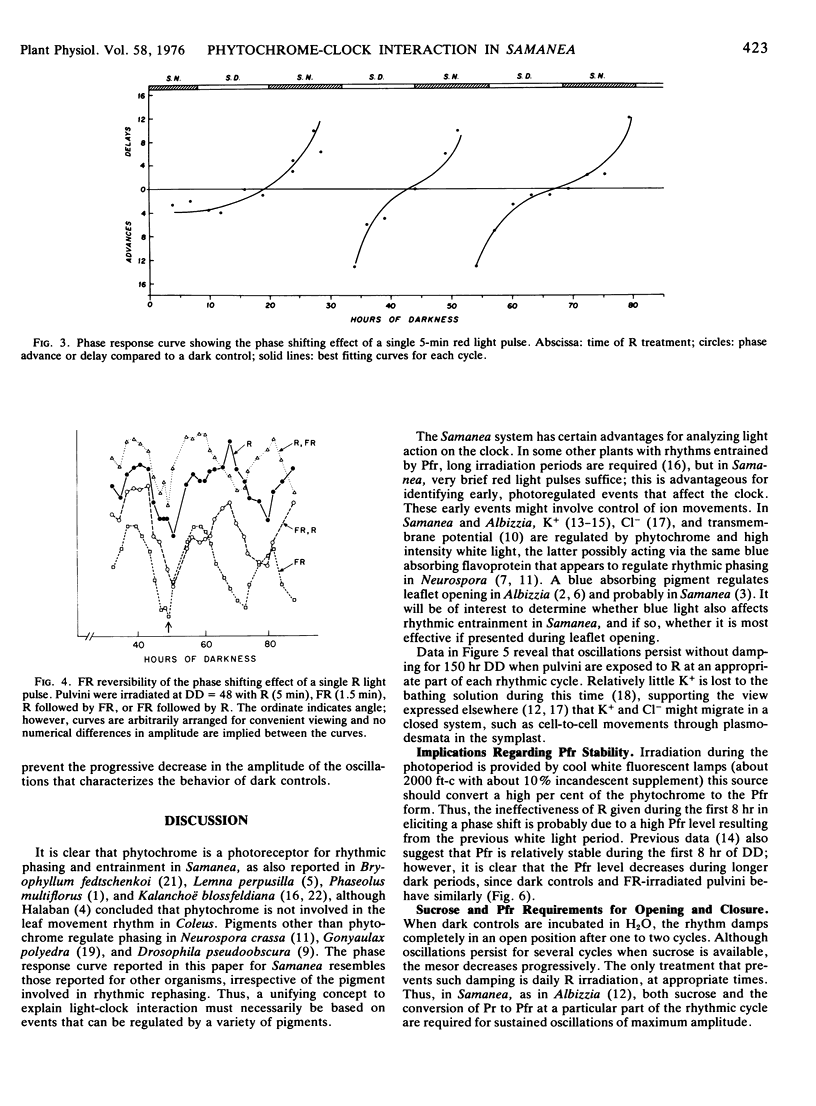Abstract
Excised Samanea saman pulvini were incubated in H2O or 50 mm sucrose in darkness for 100 to 152 hours except for brief exposures to red or far red light, and angles of opening measured periodically. When pulvini are incubated in H2O, the rhythm damps in the open position after two to three cycles irrespective of the light treatments, but when sucrose is available, the now persistent oscillations show large red, far red-regulated effects on phase, amplitude, mesor slope, and entrainment. Single red light pulses rephase the rhythm, with a phase response curve that resembles that reported for other plants and animals; such rephasing is prevented by immediately subsequent far red light, indicating that phytochrome is the photoreceptor. Red light pulses repeated every 24 hours entrain the rhythm, and also prevent damping if presented at an appropriate part of the cycle.
Full text
PDF




Selected References
These references are in PubMed. This may not be the complete list of references from this article.
- Halaban R. Effects of light quality on the circadian rhythm of leaf movement of a short-day-plant. Plant Physiol. 1969 Jul;44(7):973–977. doi: 10.1104/pp.44.7.973. [DOI] [PMC free article] [PubMed] [Google Scholar]
- Hillman W. S. Entrainment of Lemna CO(2) Output Through Phytochrome. Plant Physiol. 1971 Dec;48(6):770–774. doi: 10.1104/pp.48.6.770. [DOI] [PMC free article] [PubMed] [Google Scholar]
- Muñoz V., Butler W. L. Photoreceptor Pigment for Blue Light in Neurospora crassa. Plant Physiol. 1975 Feb;55(2):421–426. doi: 10.1104/pp.55.2.421. [DOI] [PMC free article] [PubMed] [Google Scholar]
- Racusen R., Satter R. L. Rhythmic and phytochrome-regulated changes in transmembrane potential in samanea pulvini. Nature. 1975 May 29;255(5507):408–410. doi: 10.1038/255408a0. [DOI] [PubMed] [Google Scholar]
- Sargent M. L., Briggs W. R. The effects of light on a circadian rhythm of conidiation in neurospora. Plant Physiol. 1967 Nov;42(11):1504–1510. doi: 10.1104/pp.42.11.1504. [DOI] [PMC free article] [PubMed] [Google Scholar]
- Satter R. L., Applewhite P. B., Chaudhri J., Galston A. W. Pfr phytochrome and sucrose requirement for rhythmic leaflet movement in Albizzia. Photochem Photobiol. 1976 Feb;23(2):107–112. doi: 10.1111/j.1751-1097.1976.tb06781.x. [DOI] [PubMed] [Google Scholar]
- Satter R. L., Geballe G. T., Applewhite P. B., Galston A. W. Potassium flux and leaf movement in Samanea saman. I. Rhythmic movement. J Gen Physiol. 1974 Oct;64(4):413–430. doi: 10.1085/jgp.64.4.413. [DOI] [PMC free article] [PubMed] [Google Scholar]
- Satter R. L., Geballe G. T., Galston A. W. Potassium flux and leaf movement in Samanea saman. II. Phytochrome controlled movement. J Gen Physiol. 1974 Oct;64(4):431–442. doi: 10.1085/jgp.64.4.431. [DOI] [PMC free article] [PubMed] [Google Scholar]
- Simon E., Satter R. L., Galston A. W. Circadian rhythmicity in excised samanea pulvini: I. Sucrose-white light interactions. Plant Physiol. 1976 Sep;58(3):417–420. doi: 10.1104/pp.58.3.417. [DOI] [PMC free article] [PubMed] [Google Scholar]


